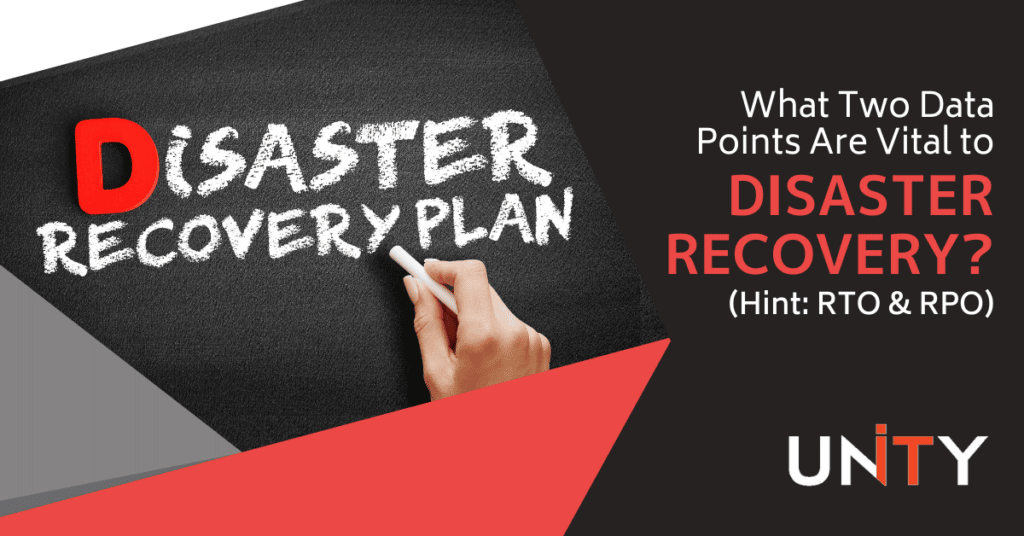
Data is the lifeblood of the modern organization. No matter what sector you operate in, you’ll undoubtedly rely on a mixture of cloud-based applications, on-premises resources and other digital tools to perform tasks, serve clients and fuel the bottom line.
Because data is so intrinsic to today’s workplace, going offline can have huge, disastrous implications. Just imagine if your office went dark, and you could no longer email customers, check orders or create products.
Worse yet, imagine that – when everything came back online – all your precious data was gone for good!
If you don’t have a disaster recovery strategy in place, this hypothetical scenario could become an unfortunate reality.
Below, we’ll look more into disaster recovery – and explore two crucial elements of any successful plan: RPO and RTO.
What is a Disaster Recovery Plan?
A disaster recovery plan is a written strategy that helps your business to navigate a disaster. In the digital world, a disaster can be anything that takes you offline: a flood, a cyber-attack or an electrical outage are all common disasters.
Your disaster recovery plan will help you to prepare for various disasters, ensuring that you act calmly in the face of disruption and get back up and running as soon as possible, while mitigating the risks of long-term damage.
Never underestimate the importance of disaster recovery. Research demonstrates that over 90% of organizations without a disaster recovery plan close forever after a disaster! Plus, about 50% of small businesses don’t survive a major disaster.
Planning is clearly crucial. If you’re yet to start on creating a disaster recovery, we suggest you prioritize this as a matter of urgency. Don’t worry if you don’t know where to start! We offer dedicated data backup and recovery services and can help you immediately.
The Importance of RPO and RTO
Two crucial aspects of disaster recovery are RPO and RTO. Here’s what both of these mean.
Recovery Time Objective (RTO)
RTO is a metric used to define the maximum amount of time your IT systems can be offline after a disaster before the outage will cause long-term damage to your business.
This metric is super important to know, as it gives you a solid timeframe to work from in the event of an unplanned disruption.
For most brick and mortar retailers, RTO is around two to three hours. The metric is measured in hours and minutes.
While this is a ballpark figure, RTO varies widely from business to business. For example, an e-commerce company will likely have an RTO of just seconds, as all of its transactions and business occurs online!
It’s worth saying that you won’t always be able to reach your RTO when disaster strikes. For example, a state-wide electrical outage could last a whole day – and this is entirely out of your control.
Still, it’s vital to know your RTO so you can understand the impact of a disaster on your business.
Recovery Point Objective (RPO)
While there is just one letter difference, RPO is completely different to RTO. While RTO is to do with your IT systems, RPO is focused on data. RPO is a metric that figures out the maximum amount of time your systems can be offline before data loss harms the bottom line.
How much data loss your business can handle will again depend on the sector you operate in. You can also improve your RPO by implementing a regular, automated cloud backup policy for critical data. That way, if you’re suddenly forced offline, you won’t lose all your sensitive files.
RPO is also typically calculated in hours and minutes – but it’s difficult to give a ballpark estimate for this metric, as RPO fluctuates widely between companies and sectors.
How to Calculate RPO and RTO
As mentioned, your RPO and RTO will be unique to your business. These metrics take expertise and experience to calculate – and we don’t advise using an estimate from the internet. Just having a calculation off by minutes could make all the difference.
Here are some factors that we take into account when calculating these metrics for our clients:
- The criticality of data to day-to-day operations
- The type of data the company works with and stores
- The sector the company works in and any regulations it must adhere to
- The company’s backup policies and data storage operations (on premises or cloud storage)
- The company’s level of maturity in terms of cybersecurity and disaster recovery
Be Prepared in the Event of a Disaster. Start Your Disaster Recovery Journey Today!
Unity IT specializes in computer data, hard drive backup and disaster recovery.
We use a unique system that automatically and regularly backs up all your vital information. Then, your data gets stored on a secure off-site server. If you happen to lose your data as a result of human error, criminal activity, or natural disaster, we will recover your data quickly and without hassle.
Contact us today to schedule a technology consultation at 559-297-1007 or reach out online.

